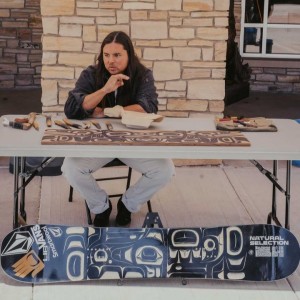
In this one, Cody talks to Tlingit artist James Johnson. Before he got to the level he’s at now, James taught himself the fundamentals of the Tlingit artform — he taught himself how to draw, how to carve, how to sharpen his knives. He taught himself the fundamentals of formline. His dad taught him the importance of traditional knowledge — that when you create a piece, you create it for your clan. Be it a paddle, a bowl, a bentwood box, a mask, a rattle, a totem pole. He says that in the old days, once the carvers were finished with a totem pole — once it was raised — they could no longer touch it because now it belonged to the people. James’ dad told him that when he finishes a piece, to let it go and, like a balloon in the sky, that piece will go where it needs to go. The main thing is to focus on skill and that your skill is going to improve with every piece you do.
Everything that he’s doing right now — whether it’s talking to an auditorium of 500 people or hosting a workshop for youth or working on a commission for Google — it’s bigger than him. It’s for his ancestors, for his culture and his traditions. It’s a reminder of the destruction and human toll of colonialism. It’s more than creating a beautiful piece. It’s about understanding history and sharing Tlingit knowledge. He does it for his clan, for his family and for his contemporaries — all of the other northwest coast artists striving to reach the golden age of their artform that occurred in the 1700s and early 1800s, after steel was introduced to their culture during the fur trade.
More Episodes
 2020-09-30
2020-09-30
 549
549
 2020-09-20
2020-09-20
 563
563
 2020-09-10
2020-09-10
 650
650
 2020-08-30
2020-08-30
 699
699
 2020-08-20
2020-08-20
 584
584
 2020-08-14
2020-08-14
 659
659
 2020-08-08
2020-08-08
 611
611
 2020-07-25
2020-07-25
 582
582
 2020-07-12
2020-07-12
 557
557
 2020-07-04
2020-07-04
 573
573
 2020-06-27
2020-06-27
 585
585
 2020-06-20
2020-06-20
 683
683
 2020-06-04
2020-06-04
 571
571
Create your
podcast in
minutes
- Full-featured podcast site
- Unlimited storage and bandwidth
- Comprehensive podcast stats
- Distribute to Apple Podcasts, Spotify, and more
- Make money with your podcast
It is Free
- Privacy Policy
- Cookie Policy
- Terms of Use
- Consent Preferences
- Copyright © 2015-2024 Podbean.com






